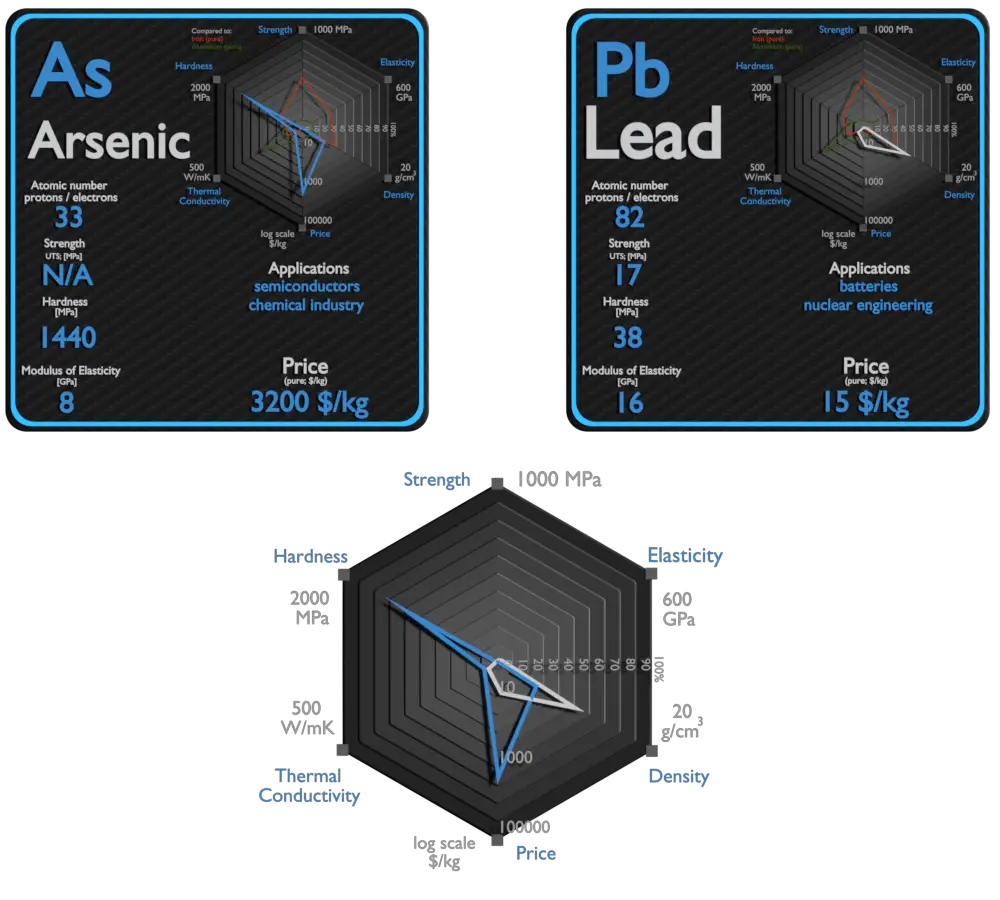This article contains comparison of key thermal and atomic properties of arsenic and lead, two comparable chemical elements from the periodic table. It also contains basic descriptions and applications of both elements. Arsenic vs Lead.

Arsenic and Lead – About Elements


Source: www.luciteria.com
Arsenic and Lead – Applications
Arsenic
Arsenic is used as a doping agent in semiconductors (gallium arsenide) for solid-state devices. It is also used in bronzing, pyrotechnics and for hardening shot. Arsenic compounds can be used to make special glass and preserve wood.
Lead
Lead metal has several useful mechanical properties, including high density, low melting point, ductility, and relative inertness. Lead is widely used for car batteries, pigments, ammunition, cable sheathing, weights for lifting, weight belts for diving, lead crystal glass, radiation protection and in some solders. The largest use of lead in the early 21st century is in lead–acid batteries. The lead in batteries undergoes no direct contact with humans, so there are fewer toxicity concerns. Lead is used in high voltage power cables as sheathing material to prevent water diffusion into insulation; this use is decreasing as lead is being phased out. A lead is widely used as a gamma shield. Major advantage of lead shield is in its compactness due to its higher density. On the other hand depleted uranium is much more effective due to its higher Z. Depleted uranium is used for shielding in portable gamma ray sources.
Arsenic and Lead – Comparison in Table
| Element | Arsenic | Lead |
| Density | 5.727 g/cm3 | 11.34 g/cm3 |
| Ultimate Tensile Strength | N/A | 17 MPa |
| Yield Strength | N/A | 5.5 MPa |
| Young’s Modulus of Elasticity | 8 GPa | 16 GPa |
| Mohs Scale | 3.5 | 1.5 |
| Brinell Hardness | 1440 MPa | 38 MPa |
| Vickers Hardness | N/A | N/A |
| Melting Point | 817 °C | 327.5 °C |
| Boiling Point | 614 °C | 1740 °C |
| Thermal Conductivity | 50 W/mK | 35 W/mK |
| Thermal Expansion Coefficient | 5.6 µm/mK | 28.9 µm/mK |
| Specific Heat | 0.33 J/g K | 0.13 J/g K |
| Heat of Fusion | N/A | 4.799 kJ/mol |
| Heat of Vaporization | 34.76 kJ/mol | 177.7 kJ/mol |








